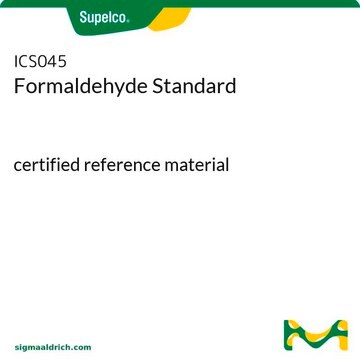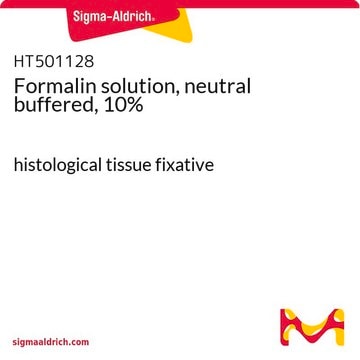1.04003
Formaldehyde solution about 37%
GR for analysis stabilized with about 10% methanol ACS,Reag. Ph Eur
Synonym(s):
Formaldehyde solution, Formaline solution, Methanal solution, Methylaldehyde solution, Formalin
About This Item
hematology
histology
Recommended Products
grade
ACS reagent
Quality Level
agency
reag. Ph. Eur.
vapor density
1.03 (vs air)
vapor pressure
52 mmHg ( 37 °C)
form
liquid
autoignition temp.
300 °C (Formaldehyde)
572 °F
expl. lim.
7-73 % (v/v) Formaldehyde)
concentration
36.5-38.0% (iodometric, acidimetric)
pH
2.8-4.0 (20 °C in H2O)
Looking for similar products? Visit Product Comparison Guide
General description
Analysis Note
Assay (iodometric): 36.5 - 38.0 %
Identity: passes test
Color: ≤ 10 Hazen
Appearance of solution: passes test
Free acid (as HCOOH): ≤ 0.025 %
Density (20 °C): 1.080 - 1.090 g/ml
Chloride (Cl): ≤ 0.0001 %
Sulfate (SO₄): ≤ 0.002 %
Heavy metals (as Pb): ≤ 0.0002 %
Fe (Iron): ≤ 0.0001 %
Methanol (GC): 9.0 - 11.0 %
Sulfated ash: ≤ 0.002 %
signalword
Danger
Hazard Classifications
Acute Tox. 2 Inhalation - Acute Tox. 3 Dermal - Acute Tox. 3 Oral - Carc. 1B - Eye Dam. 1 - Muta. 2 - Skin Corr. 1B - Skin Sens. 1 - STOT SE 1 - STOT SE 3
target_organs
Eyes,Central nervous system, Respiratory system
Storage Class
6.1A - Combustible acute toxic Cat. 1 and 2 / very toxic hazardous materials
wgk_germany
WGK 3
flash_point_f
143.6 °F - closed cup
flash_point_c
62 °C - closed cup
Certificates of Analysis (COA)
Search for Certificates of Analysis (COA) by entering the products Lot/Batch Number. Lot and Batch Numbers can be found on a product’s label following the words ‘Lot’ or ‘Batch’.
Already Own This Product?
Find documentation for the products that you have recently purchased in the Document Library.
Customers Also Viewed
Protocols
Preparation of a standard solution for Formaldehyde
Related Content
Learn about the criticality of biological tissue staining for research and clinical pathology using standard and special stains and dyes.
Our team of scientists has experience in all areas of research including Life Science, Material Science, Chemical Synthesis, Chromatography, Analytical and many others.
Contact Technical Service










